August 2021 Wrapup!
And thus, the flourish, the finale, the end of the performance, and tricks month draws to a conclusion. This was an interesting month, as many of the pieces were quietly done throughout the year, and postponed to now; this created a strangely out-of-time experience as, when written, I felt ‘well, I’m going to need to explain a lot about Qanon, I guess,’ as opposed to the relatively mainstream bullshit it is now.
Still, let’s have a look at the blog, shall we?

Story Pile: The Great Pretender
Anime is a crapshoot.
This slot has been tied for The Great Pretender for the better part of a year. The plan was, after seeing it, being so intrigued with the opening, that I’d watch the whole thing in the first few months, once Crunchyroll had it on their ads-paid area.
When I felt it was time, I watched the first two episodes.
Thought about it…
And stopped.

MTG: August’s Custom Cards: Tricksy Cards!
With the end of tricks month we have another collection of daily Magic: The Gathering cards. This month, we didn’t have a mechanical identity to work with, but instead we wanted to work with the same theme of TRICKS.

How To Be: Disney’s Robin Hood (in 4e D&D)
In How To Be we’re going to look at a variety of characters from Not D&D and conceptualise how you might go about making a version of that character in the form of D&D that matters on this blog, D&D 4th Edition. Our guidelines are as follows:
- This is going to be a brief rundown of ways to make a character that ‘feels’ like the source character
- This isn’t meant to be comprehensive or authoritative but as a creative exercise
- While not every character can work immediately out of the box, the aim is to make sure they have a character ‘feel’ as soon as possible
- The character has to have the ‘feeling’ of the character by at least midway through Heroic
When building characters in 4th Edition it’s worth remembering that there are a lot of different ways to do the same basic thing. This isn’t going to be comprehensive, or even particularly fleshed out, and instead give you some places to start when you want to make something.
Another thing to remember is that 4e characters tend to be more about collected interactions of groups of things – it’s not that you get a build with specific rules about what you have to take, and when, and why, like you’re lockpicking your way through a design in the hopes of getting an overlap eventually. Character building is about packages, not programs, and we’ll talk about some packages and reference them going forwards.
This month, I felt it was time to approach the challenge from a different angle, of taking something with an obvious, easy, simple solution and then exploring around that. And for that, we’re going to look at a classic character, a character who’s so well known we don’t even remember we’re referencing him when we reference him. A folk hero, a hero who defined a generation and set thousands of people on their path that would determine the kind of person they’d be.
We’re going to look at Robin Hood.
Specifically, the 1973 Disney’s Robin Hood.
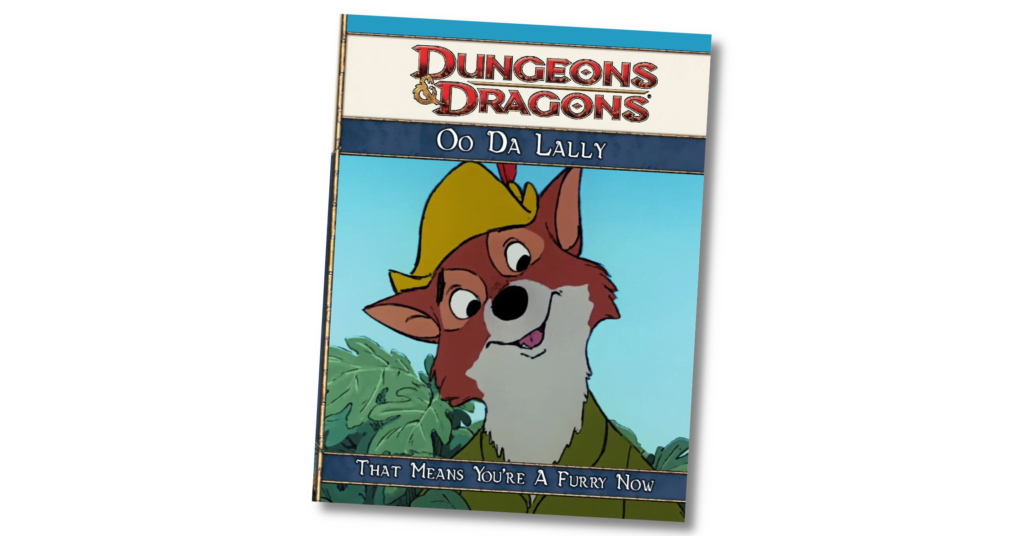
Game Pile: Magic Trick
This is a cute little game about playing a skateboarding kid in a town of animal people. It has pickups and tricks and magical powers that give you fast travel. It’s not a long game and I imagine if you’re better at skateboarding games than me, it’d probably only take a few hours to finish. It’s charming, it’s sweet, there’s a trans flag in the banner art.
If you want to check the game out, you can go get it here, and also, if you bought the Bundle For Racial Justice back in 2020, you already own a copy. But it’s also really cheap, so maybe buy it again?
I’m thinking more and more when it comes to itch games, just showing them off on my platform and talking about what I like about them is more interesting than trying to apply some deeper analysis to them. Not that I won’t for games that inspire it, but especially when it comes to games like this, I want to make sure I’m taking the opportunity to just share games.
Be kind with energy,
Be cruel with purpose.
3.0 D&D: Everyone Shapeshifts
Min-maxed 3.0 D&D was fucking weird.
I use the term 3.0 to talk about ‘third edition’ because there’s this weird way that people treat ‘3rd edition’ D&D as a single game, and not a period of time between the last release of 2nd edition and the first release of 4th edition. 3rd edition content is still being made and the game is still being played, even if I’d moved on from it. Important to this, though, is that ‘3rd edition’ is a term that I feel inappropriately ambiguates the two games made in 3rd edition.
When people are criticising 4th edition — hey maw he’s defending 4th edition gain — sometimes you get a ‘timeline’ argument; the idea that 4th edition, as a game that was only actively published and promoted for six years before the introduction of 5th edition. 5th edition has been going for 7 years since then (two of which were pandemic years), and 3rd edition went from 2000 to 2008, showing that 7 and 8 years are ‘good’ times for a game to exist, and 4th edition’s 6 years indicate that it was a ‘bad’ time. Thing is, 3rd edition D&D, the thing before 3.5, was only around for 3 years, and it was not the same game as 3.5. You couldn’t just pick up classes, creatures, or monsters and port them over. First party feats and classes were generally all weaker than 3.5, and spells were largely stronger.
4th edition never released a supplement that wasn’t compatible with all of 4th edition. By comparison, 3.0 lasted for 3 years, and 3.5 lasted for four – an immense rules patch apology.
And trust me, it was an immense rules patch.
Like, did you know in 3rd edition, in min-maxed groups, you basically never bothered building for physical stats if you were starting after level 3 or so?
Because in a min-maxed party, you very rarely were dealing with un-polymorphed characters.
Continue Reading →Chess “Doping” and Outside Notes
Right now, Chess is having a doping problem.
Yes, Chess.
Yes, doping.
CW Drugs, but also no, not drugs.

The Mormon Murders
Let’s talk about conspiracies.
Let’s talk about lies.
Let’s talk about protecting very important lies.

A content warning, though. I am going to talk about Mormonism, Mormon history, and the Mormon church. I don’t believe in Mormonism’s depiction of history, and I do not believe that the historical record of Joseph Smith is somehow corrupted. If you don’t want to hear an outsider speaking frankly about his opinion of Mormonism — and you probably know what that’s going to be like — then I recommend you skip on out.
Continue Reading →Story Pile: Now You See Me 2
This movie is shockingly bad.
That’s not hyperbole; when I watched the first Now You See Me I was shocked at how bad it was, with the structure of the movie and its general incompetence creating this sort of impossibly tangled mess of failure. To describe the plot of that movie is to rush past constant cul-de-sacs of narrative failure, an act of will that requires you to treat the movie as if it’s better than it actually is, because of its bottomless well of failures. Now You See Me 2 takes that bottomless well of failure and installs a sub-basement, in all the ways that unnecessary sequels do.
This original movie was terrible, and this movie is aggressively worse.

Being That Guy About Magic
Hey, you know that guy who brings a guitar to every party?
And how everyone hates that guy?
You know what’s even worse than being the Wonderwall guy?

Being a guy who can (and wants to) do magic tricks.
CoX: Wolfbit
Time to time, I write up an explication of characters I’ve played in RPGs or made for my own purpose. This is an exercise in character building and creative writing.

Cody always knew someone. He was the kid who knew everyone shifty, who could get you favours, who could find you things off the books. He never really worked out why he was good at it, why he could remember these trades so well, why he could read the people around him for what worked, what made sense about them.
When the wolf woke up, it made a bit more sense.
He’s a fixer, a bit of a crook, certainly a bit grubby. There’s a lot of ways poor people make things happen in the city, and in the dark spaces, sometimes you hope to find the wolf.
Continue Reading →Game Pile: Kyrandia 3: Malcolm’s Revenge
The medium is the message. If you look at the way things are made, rather than the content that is presented, you can see patterns of behaviour, see deformations of the way that things got made. The point-and-click adventure, for example, tends to get framed as a sort of game creature that evolved on the PC platform, existed for a while, then classically died out out of incompetence.
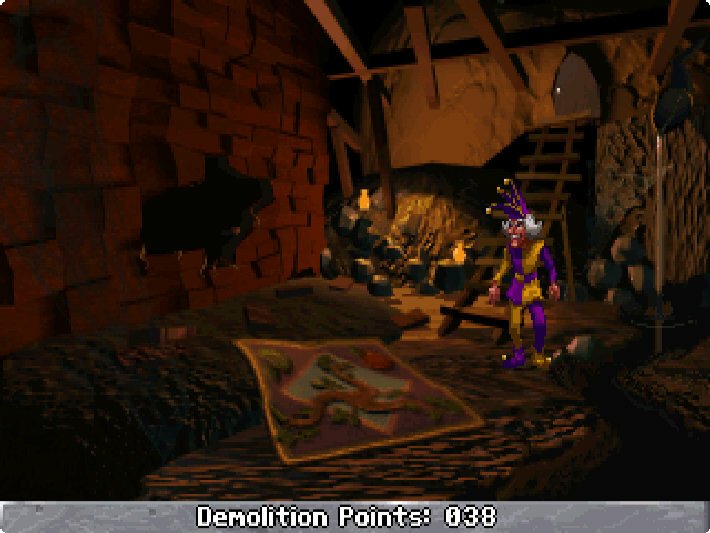
The Eucharist Wafer Conspiracy
Who doesn’t love a good Catholic conspiracy theory?
Not one of the conspiracy theories the Catholics have used to shape the way the world views faith and itself, no, those tend to be a bit more… well, they’re the conspiracy theories that we think of as ‘conspiracy theories,’ and they almost all seem to trace back to someone saying ‘Well, Martin Luther was wrong about a lot of things, but as far as it goes on the jews.’
And this isn’t one of those Protestant conspiracy theories about Catholics, which range from ‘they put cornflakes in their bed to stop masturbating’ (kinda true) to ‘they can’t whistle or the pope will hear,’ (definitely not true). It’s about eucharist wafers, and it’s about a conspiracy that, seemingly, some Catholics seem to think exists despite not believing in it.

The Eucharist wafer, if you’re not familiar, is a small bit of more-or-less bread used in a ritual known as the eucharist. During the Biblical narrative of the last supper, a ceremony we mostly document from the one person who definitely makes it clear he was not there, Jesus gives a speech where he offers the disciples wine and bread, saying, and I paraphrase, ‘Come, eat of this, for it is my body and blood, eat it in remembrance of me.’ It’s something Protestants and Catholics share as a ritual.
It is, however, supremely weird.
It’s really one of the sources of dissent between Protestants and Catholics – there’s an idea that this ritual, along with the baptism of infants, was basically one of the things that got the ball rolling on all the schisming and that’s why one of the major groups of not-Catholic Christians that hate the Catholics a lot (except when they’re trying to leverage them for political power) are known as ‘Baptists.’
The weird ritual is a little weirder in Catholic circles because of a belief known as transubstantiation. This idea is that the eucharist, when consumed, literally transforms into actual real Jesus meat and actual real Jesus blood. This belief was used to claim that Catholics were cannibals and tie them to blood libel (and what the hey, we’re back at the Jewish stuff again, that’s weird and sucks).
Transubstantiation is contentious because this idea, that the wafer and wine become real blood and meat is actual Church doctrine. That’s like, inasmuch as there are rules on this stuff, that’s what the rulebook as written says is there. The consensus amongst Catholics in the United States is, however, that this isn’t true; about two thirds of Catholics think that it’s entirely symbolic, just under one third believe it’s not. The church says it’s true, most people don’t believe it.
This makes it an interesting question to ask about on forms, and that gave us this beautiful graph from August 2019.
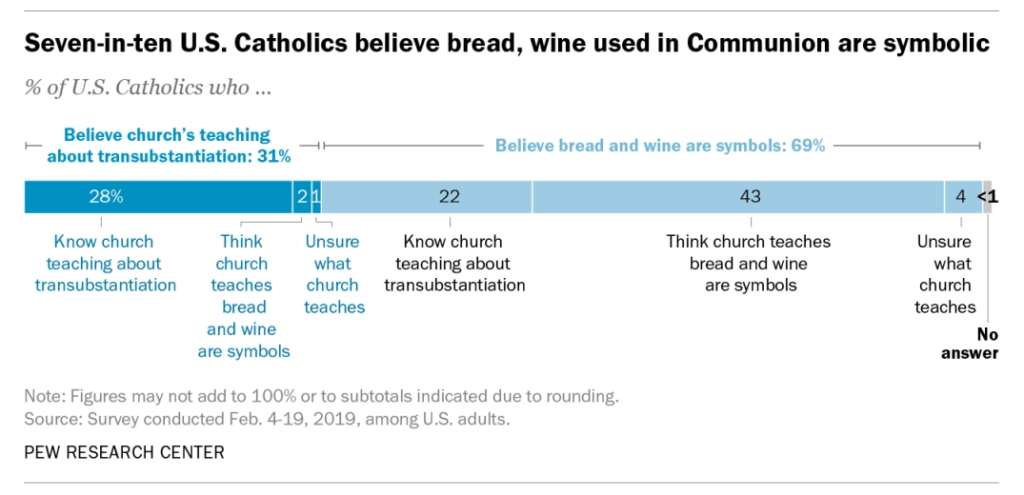
In this graph, we see that 69% of people (nice) don’t believe that the eucharist becomes real god meat. 31% believe it does. But there’s a breakdown in that; of the 69% of catholics who think that the bread and wine are symbolic, about two thirds of them think that the church also teaches that the wine and bread are symbols. This means that of the entire cohort, almost 45% of Catholics think that the bread and wine are symbolic, which is incorrect, according to the Catholic church itself.
Here, though, is where it gets wonderfully weird.
There is a cohort of 31% that believe that the food they are eating is magically transformed into god meat and blood. This is made up of a body (hah) of around 14 million Catholics, who believe in transubstantiation and who also believe that the church teaches transubstantiation. Yet next to them, in that weird little sliver, is that 2% that believe that it does become god meat… but that the church teaches it doesn’t.
What the heck.
What do they think happens there?
It’s this beautiful little bubble. How do you believe in a core point of doctrine for your church while believing they don’t agree with you, while also believing the weirder thing. Believing that you are secretly transubstantiating with a ritual performed by a priest who you also think is not doing the thing required for transubstantiation to happen, but you’re somehow bootlegging Jesus Bacon into your system some other way?
A little secret community of roughly a million Catholics in the United States.
Weird, huh?
We Are The Night: Aspirations, Contusions, And Bullshit
These articles document the ongoing process of examining the things required to make a Blades in the Dark hack. The premise is using Blades in the Dark to emulate a heroic vigilante environment, akin to the settings of Gotham City from We Are Robin, or Ikebukuro from Durarara!!

This time, I want to talk about a mechanical change to the injury system. We’re going to talk about Harm and Trauma, and ways to change that system.
Continue Reading →Henry Orenstein
I’m going to tell you a story. It jumps around a little, to future and past, and it has a big twist in it that I’m going to need you to trust me on. Because of that, the fold – and content warning – is coming later than you’d expect.
This story, started, for me, on the Transformers wiki.
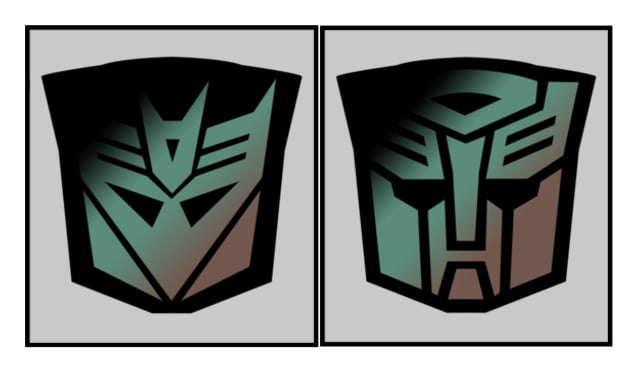
This is a Rubsign. It’s a small piece of plastic that’s heat-reactive. When Transformers started out as a brand, there was an immediate push to make cheap knockoff toys with similar ideas. In order to ‘protect’ the brand and ensure kids only wanted to buy the genuine Transformers, they developed something that they could pretend was part of the play pattern: a small symbol on the robot’s body that had the silhouette of either the Decepticon or Autobot faction, and you wouldn’t know for sure if you didn’t heat it up, usually as a child, by rubbing it with your finger.
Transformers, and their gimmick of ‘transforming’, is essentially, open source. You can’t copyright it or even copyright the techniques of a mould. This is one of the reasons there’s so many knockoffs of those toys — the actual technique of a transforming toy is pretty much uncopyriteable method.
The rubsigns, however, were made with patented technology; not only weren’t other people allowed to put them on their toys, but even worse, they simply couldn’t make them because the method for their creation was proprietary. What I thought as a child was a clever way to represent a disguise, for a moment of tension in the narrative, was really just a corporate control collar, a thing that meant they could draw a hard line between their version of the idea and the other, shitty ones, so I could ensure my collection of second hand transforming robot toys was properly branded.
Rubsigns are a cop is what I’m saying.
But, they had to be invented.

This is Henry Orenstein. Learning about the origin of the rubsign meant learning that to my surprise, the patent for them is not held by The company per se, but is instead partially owned by Hasbro, and partially owned by this one dude, Henry Orenstein.
When I found his name in the Transformers wiki, the wiki stated, perhaps boldly: His life is more interesting than Transformers.
Bold claim.

This is professional Poker. It’s a well known game that involves players playing for extremely large sums of money, often with similarly large sums of money involved in the buy-in. It’s grown in popularity over the past twenty years, in part because of improvements in presenting the game to an audience. Back in 1995, a patent was filed for a device known as a hole camera, which let the broadcasters collect the information about the players’ hands without doing anything that disrupted the natural flow of the game. The hole camera was used in 1999, and that’s about when poker started to pick up in public discourse.
And the patent for the earliest hole camera (which isn’t used much any more) is to a guy named Henry Orenstein. So important was this – and his winnings and his achievements lifetime – that he’s been inducted into the Poker Hall of Fame.

This is a Johnny Seven OMA, which were made by Topper Toys. And that’s a company Henry Orenstein founded to make his toys after being annoyed at how expensive dolls and toy guns were for poor kids. Topper Toys eventually folded into another brand, Deluxe Reading, which I understand if you are a hardcore toy collector, really into things like barbie accessories and cross compatibility, is very important to the hobby.
This background was how Henry got the attention of Hasbro, and wound up working with them on acquiring new toy properties. That meant he was in position to be in Japan, looking at Takara and Microchange toys, and come back with the idea of acquiring both toy sets, and rebranding them as Transformers in 1980.
Interesting dude, right? He should write a memoir.
Except he did already:
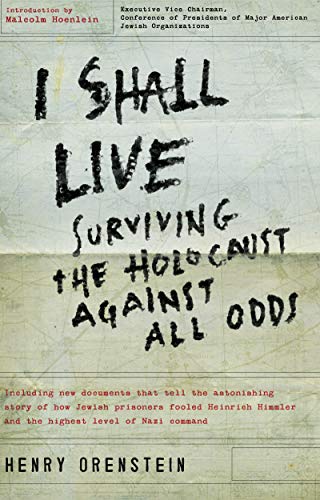
And now, when we jump back in the story, I have to say: Content Warning: Nazis.
Continue Reading →Story Pile: Wind of Change
Do you remember the song Wind Of Change?
Or, knowing my audience’s typical age, do you know that song your older sibling or parent or wine aunt or board game uncle liked, Wind Of Change, by 80s metal band Scorpions?
What if I told you that that song was not by Scorpions, but was, in fact, a CIA op designed to undermine the Soviet Union?
Okay, there are four broad responses to that idea and it depends on how you see media and how you see the CIA. If, for example, you think media is a completely powerless element of our reality, just a reflection that people partake of with no effect, and CIA as a sensible wing of the US government that largely spends its time listening to ambassadors and definitely not doing anything weird or unreliable with an enormous black budget, this probably sounds completely silly.
But if you see media as powerful, or you see the CIA as a pack of unaccountable weirdoes who occasionally destabilise governments ‘just in case we need that coup later’, then suddenly every part of it gets a little more believable.
And if you think that the media helps us shape our reality, especially as it pertains to political movements and popular uprising and that the CIA are the kind of organisation that spent thousands of dollars on developing cats that explode and dog poop radios, and then the whole thing sounds very believable.
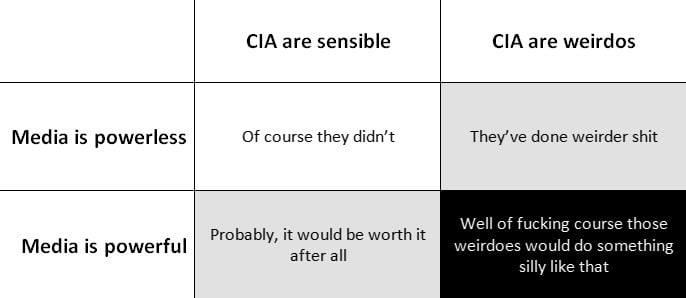
This idea doesn’t come out of nowhere, mind you.
It comes from the CIA.
So Russia Was A Thing That Happened, Huh
Content warning: I’m going to talk a brief bit about the Q conspiracy, and US Politics, particularly 2016 and the 45th president of the United States!
Continue Reading →Every Church Has A Conspiracy Theory
Qanon has been a surprising opportunity for a lot of people to learn something they probably never realised before: That the conspiracy theory wing of the world was bountifully alive, well, and extremely well-fed, in the existing landscape of Christian dominionism.
Content Warning: Church, Qanon and related subjects, American Christianity, and Conspiracy Theories.
Continue Reading →Game Pile: The Solitaire Conspiracy
Hey, here’s some leading text because I want to make more than just the youtube video show up in the tweet, and oh goshy gee! I like this game.
The Death of the Phonebook
Hey, do you know why you see magic tricks done with playing cards?
Continue Reading →Instant Stooging
People are really helpful.
In magic performances, the stooge is a person who seems to be unaffiliated with the performance, but who secretly is. You might also know this kind of performance, where an audience member or seeming bystander is roped into the performance, as one that uses a plant. This extra character is super useful — there’s a lot of different magic tricks that need this kind of tactic, they can be useful for setting up puzzles or even just introducing a prop that wasn’t there before. There’s a lot you can do with an extra pair of hands.
There’s also a thing where these days, with the prevalence of phones, and the potential for a trick to involve things like dialing a number, having someone who can pick up a dialled number is important too. There’s stuff you can do with recordings, but really, it’s just easier to have an accomplice who can answer or call some thing, right?
Stooge techniques open up a whole range of possible performances, but it’s not uncommon to see magicians and performers quietly disdaining stooging. I know the hypothetical argument against stooges when doing street cons is typically that you’ve halved your take – after all, one other person involved is someone else who can get caught, someone who can tell the police, someone who can get beaten up and interrupt your scam. It’s just a point of failure. This carries through to stage magicians, where the margins can often be extremely thin, and paying a plant is a meaningful cut of your earnings.
I don’t think it’s entirely economical, mind you. I don’t like using plants or stooges, because it’s hard enough to find someone who wants to see a magic trick, let alone someone who might want to collaborate on one. Also, just… it seems less clever? It’s a different skill axis, and that skill definitely deserves attention and respect, it’s just it’s not the skill I like developing.
Some magicians like to refer to stooging as a cheat, which I think overstates it. That creates the classic magical gatekeeping problem. It’s just that if you’re focusing on skillset A, for effect B, introducing skillset C just isn’t what you want to do. Magic cares about methodologies, after all.
This method, though, also introduces a really interesting piece of social engineering.

When you have a cohort in the crowd you use to make the trick happen, that’s stooging. But you can grab someone, out of the audience, and when you pull them up, you can just tell them to do things, and they will, usually do it. And I don’t just mean ‘come here, stand here,’ I mean you stand there, and you whisper in their ear stuff like ‘just say schnapps’ or ‘there’s a secret panel in the back of the box, press it.’ And … they’ll do it? They won’t stand there and go ‘hey, this guy is asking me to cheat,’ or ‘hey, I thought this was a magic show!!’ or stuff like that.
This is known as instant stooging, and it’s really wild, because you’d think surely that wouldn’t work.
You can do it a lot of different ways. Some classic magicians were fond of using kids in their acts because hey, a kid is innocent, they couldn’t be a conspirator, of course. What was happening, though, was the magician was, once the kids were close, threatened the kids and that kept them behaving in accordance with the trick. Which is a novel stunt, but also, wow, fuck you buddy.
Instant stooging has a problem in that when it fails, it tends to fail catastrophically, but good magicians are also catastrophe planners; lots of tricks are designed with a ‘get out’ clause to make a failure funny or to make it look like a setup for another part of the set. It also scales up in weird ways; if your show has props or sets that require containment, you might not want someone on stage who might be unpredictable, after all. When you have a really small audience, like three or four people, stooging one of them might be hard because when are you going to have the other people distracted?
Ultimately, though there’s a simple truth for why this tends to work: People are helpful.
4e: Sneaky Feys
It’s said, that humans learned magic from the gods; some say that humans learned it from studying the universe around them. Some, in the oldest and darkest stories, say that humans learned magic from the fey, because they couldn’t wait to see how badly we fucked it up.
One thing I love about D&D 4e is the way that making a character is pretty simple and robust. Rather than gate things like werewolves and werebears behind layers of power back in third edition, the game finds ways to let you play that straight up, out of the gates. Same with Vampires, and, if you want, you can play all sorts of weird character types out of nowhere.
If you want to play a weirdo, fae-realms inspired fey creature, you have options too! And, of them, the Satyr and Hamadryad, are bad. Fortunately, though, Fox made some better ones, and I’m going to give you some feat support for them!
Now, this is a bit of a different direction in the kind of 4e content I make. This isn’t about something from established books, this is something based on the character heritages for 4th edition that Fox made. It’s going to be about feat support for the Gruuwar, Pooka, and Firbolg heritages she wrote, and put up on The Square Fireball.

Story Pile: Capricorn One
Morning.
The TV broadcast is rolling.
The silhouette of the rocket on the launching pad, the black shape created by the cresting sun.
The sound, from somewhere, to somewhere, about the countdowns, about the tanks being flooded, about the expectations of the mission. About the vast things humans have done, to make this happen, about how this is a first step on a months long path.
About this, the first crewed flight to Mars.
…

And then, someone taps on the side of the module where you’re sitting, and says: You need to get out. We need to talk.
Capricorn One (1978) is a conspiracy thriller movie about NASA trying to fake an extraterrestrial landing in order to avoid embarrassment and funding failures, and the escalation required to maintain a conspiracy that does not hold.
Continue Reading →T-Shirt Megapost: Subject Outlines 2
Yesterday I started on showing off this month’s t-shirt designs, and boy there are a few this month. I would normally put t-shirt designs at the end of the month, but in this case, I’m actually getting these shirts in time to wear them for this semester… which is also the same time any of my peers might want to see them.

Sonic The Hedgehog logos are really quite good. It’s a standardised font, it’s a standardised formatting, and the rest of the logo is done with individual specific details for the media in question, like Mania’s springs and whorls. This was really, really easy to make and it looks great.
I think sometimes it’s easy to fail to appreciate just how good the branding is for Sonic.
Also, there’s a version of this with ‘& Knuckles’ on it, but it honestly doesn’t look as good and means the joke ends on a second punchline, and that sucks.
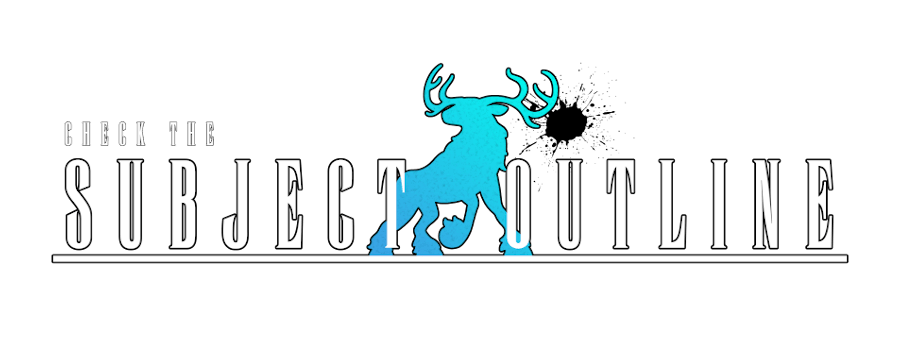
This was based on the suggestion of my dear friend Shelf, who pointed out that while yes, it looked like a Final Fantasy logo to start with, I needed something crystalline in the middle. Fox also pointed out that it’s where a splash of colour happens. In this case, it’s a silhouette of an elk.
Because elks are cool.
The elk is a gradient that then got ran through a cubism filter to make it look kinda crystall-y.

Speaking of that cubism filter, get a load of that crystal in my extremely home-made leadership matrix. The matrix is entirely out of gradients otherwise.
The text is really interesting because my memory of the gradient on this is really vibrant – a really rich red, a really deep blue. But if you go back and look at the G1 logo for Transformers, it’s… positively understated.
This gradient is made up, in order from the top of the image to the bottom, a gradient of blue-to-white; a line of garbage hand-drawn then smoothed and smudged to look a bit more like a mountain range; a gradient of red to white. The bottom of the garbage line gets blurred into the red-white gradient, and that’s how I got that effect.
I’m really proud of all these things that don’t require me to like, do much drawing vs making my designs with shapes, rotations and symmetries. There’s a lot of that here.

And finally…
God damn.
I wanted to make a shirt with the design from the Vaporwave Designer meme program. But the thing is, that’s not only not at a proper resolution for shirts, but it’s also really busy for a design when I can’t control all the elements of the shirt. I can’t cover the entirety of the shirt, to give it the proper background. I can’t do gradients either – less-than-full opacity, when printed on a shirt, is printed on white and creates a nasty white silhouette.
With those limits, instead of duplicating that style, I wanted to make something that evoked it, in colours I like. And thus, we get this hodge-podge of ‘wow, look at all the effects I can do.’
If you’d like to check these shirts out, maybe buy a sticker or a shirt… well, check it out here.
T-Shirt Megapost: Subject Outlines 1
ha ha ha or maybe we’ll have another lockdown after I write this post and the next one and these shirts will instead not get worn at class but oh fuck it here it is anyway
I like wearing my shirts to class. You maybe have seen my bumper collection of Loss shirts that I wear to teach a class about memes. One shirt that got a yell of laughter last semester was my ‘Have You Read The Subject Outline’ shirts.
Well, as this post goes up, I’m going to be teaching again this semester, and I made a bunch of other shirts of that joke so I have a full matching set for the semester. Here, then, are the first half of them, with some notes about how I made them.
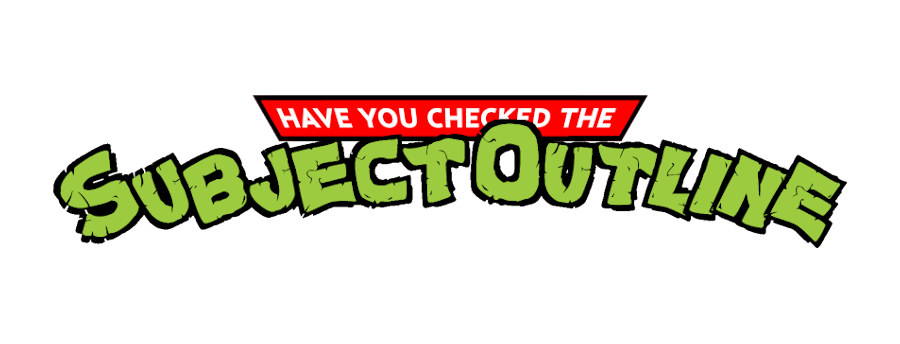
The actual phrase Have You Checked The Subject Outline scans to the Teenage Mutant Ninja Turtles cadence. Thanks to one Glench, a tool exists on the internet for building a framework for that kind of design.
In this case, the output of the creator just gave me the angle/style of fonts, and then I went and recreated them myself once I had someone else doing math on the arc of the letters.
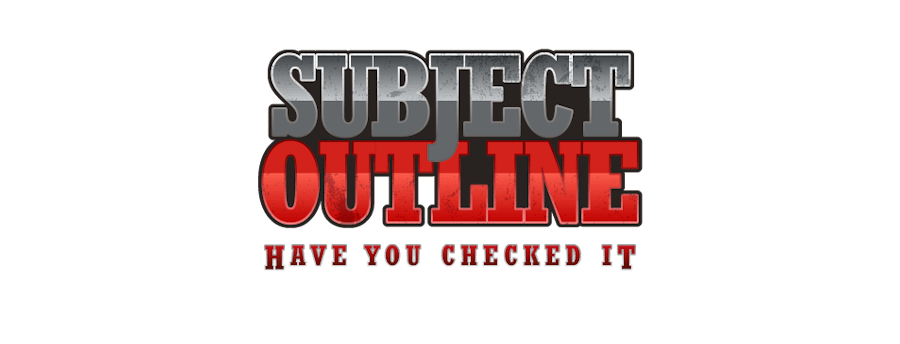
The Fullmetal Alchemist logo is composed of letters, with specific kerning and details, that I seem to have installed as part of a system package. To get this look, I pulled the spacing in tight for the body text to make sure that the two most similar words fit the same bounding box. Then, it was a matter of giving it a pair of outlines – which I noticed, a lot of things rely on outline-thicker-outline, which does look great.
This is mostly just sets of gradients; one gradient for the red body, another for the red outline, same for the greys and silvers.
Note that in this design because the original logo doesn’t have a hanging element (the foot of the J), I had to then restructure things a little; I couldn’t just make SUBJECT and OUTLINE separately, because otherwise the bottom edge of SUBJECT would overlay on the top edge of OUTLINE. In this case, I put the topmost layer (the inner body text) paired together, with SUBJECT on top; then under those two, the outlines, then under that, a grouping. Then I had to make space to make sure the outline on the J fit.
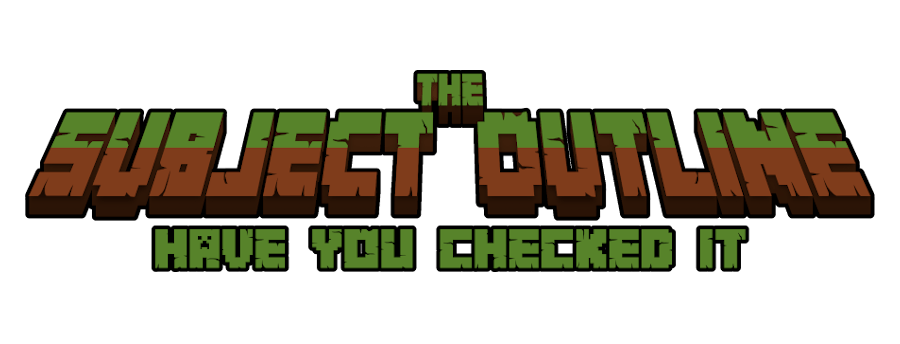
Design number three went through a lot of iterations. There’s a free font for minecraft, but to get the 3d effect I had to do a lot of struggling. First, create two layers of text, with a distressed/non-distressed font. Then I used a perspective tool to make it tilt backwards.
Once I had that, I took a copy of the bottom layer, the un-distressed one, and gave it a vertical motion blur a pretty big distance, then made a folder for the blurry one. I copied it a dozen times, merged those, and then made a copy and got rid of all the contrasty bits to make sure it was a ‘solid’ shape rather than a blurry one.
Then it was a matter of just trying out a lot if graphical effects to see if I could get a ‘dirt’ vibe without using textures I didn’t own and wasn’t allowed to use. I did toy with pixel blurring photos, but that got me inconsistant pixel sizes, and that was super annoying and looked a bit crap.
That’s half of these designs, we look at the next set tomorrow!
Game Pile: Among Us
Among Us is a 2018 social deduction videogame, developed and released by Innersloth games. It is a borderline omnipresent media thing right now and you may have seen it on like, kid’s t-shirts and stuff if you are lucky enough to be able to walk around outside right now. There’s a non-zero chance that you don’t know what this game is or how it plays, so I’m going to fly through that real quick.
In Among Us, players are dropped into a play environment (known as the map) with nothing but their little blobby toes and a team affiliation to their name. Then they’re required to do a number of tasks to ‘fix’ the map — like, getting a spaceship going, for example — and that’s it.
Oh, wait, that’s what you have to do if your team is ‘crew.’
See, in any given map, there is one, and maybe two non-crew members, that look like crew members but aren’t — they’re a fangly shapeshifting alien (or aliens) — and they want to sabotage the tasks and kill off all the other members of the crew. This is obviously bad, so, whenever a player discovers a body, they can call for a meeting, where the crew can vote on who they think is the murderer (or not vote, if they so want), and if someone gets a majority of the votes, they’re spaced.
This creates the basic systems of the game. The alien wants to isolate people and kill them in places that are likely to go undiscovered, build a cover identity and defray suspicion. Non-aliens want to get their tasks done without being killed, and without being perceived as suspicious, for fear of being flushed out into space mistakenly. Alien wins when they’re equal or majority of the crew, crew win when all their tasks are done or the imposters are disposed of.
There are, I think, maybe two forty year olds who read this blog who may be going: Oh, is that it?
And yeah, that is it.
Continue Reading →Jesus Mythicism
I don’t think Jesus existed.
I mean, there’s scholarship on it, and for some of you, ‘no, we can give the concession,’ and there’s a host of opinions. Lots of people I know, atheists even, even active anti-thesists, think that Jesus existed, or rather, say that they think that Jesus was a ‘real person’ and attribute the teachings in the gospels to that person.

I don’t. I don’t see how I have to give that concession. And, like, I think the idea that ‘there’s a real kernel of truth’ to Jesus mythicism is really weird. Why? Because the text that describes Jesus also describes massive sermons memorised perfectly, specific literary devices that would be very unnatural as observed practice, historical characters behaving wildly out of character, an actual zombie apocalypse, and people coming back from the dead. Those things don’t happen, meaning any text that includes those things is inherently suspect. Like, The Walking Dead happens in Macon, Georgia, and the fact that Macon exists doesn’t mean that The Walking Dead is a good text to use to learn about it.
And largely, the thing is… what is there left, then? If you take all the stories in aggregate and just drop the stuff that contradicts one another, and the stuff that absolutely could not have happened, you’re left with a very vague outline that at some point, a dude named Jesus existed. Historically, the best record we have is a hundred years later is people saying ‘hey, Christians exist, and they say this is their backstory,’ which I mean, that doesn’t mean anything. Every religion we’ve ever seen founded with good record keeping has an obviously nonsense origin story, why is this the one we take seriously? Because that’s the only records we have? But those records also have again, total nonsense in them.

There are some academics who have written on the topic*, and they construct a reasonably solid argument for the mythical nature of the Christ story. In 2007, the Jesus Project was kicked off to attempt to settle the question in an independent and authoritive way, only to be shuttered two years later when its own coordinator determined that the project could neither get reliable enough historical information to prove Jesus existed, nor could it in any way verify the idea that Jesus did not. There was also a problem with how the researchers seem to split into people who assumed Jesus was real and people who didn’t, which meant there wasn’t a proper skeptical framework. And when people say ‘we have more proof of Jesus than we do of Julius Caesar,’ it’s kinda this auto-disqualifying position, but it’s seen as the norm to say that.
Personally, I think that the way we give Jesus the benefit of the doubt is a form of religious privilege; that Jesus gets held to a much lower standard of evidence, because well, there’s all this stuff. Look at how much Christian-ness there is around us, surely the history of this church has to be, like, based on something right? And we defer to the experts within the textual space, in the privilege superstructure of the church itself. And like, surely there have to be good sources for this, right? Right? It’s a coincidence I’m sure that in our Christian culture surrounded by Christian media with Christian colleges that have Christian teaching positions for Christian students that there’s a bias towards selecting academics who may think that there’s something to this Christianity nonsense.
One predominant complaint about mythicists that’s used to dismiss them wholesale, tends to be ‘these people aren’t getting hired in academia,’ which I mean, that sounds like a hiring practices problem? Like, the argument seems to literally be ‘we don’t hire mythicists, and none of these mythicists work as professional scholars.’
Anyway, I find the entire idea of a historical Jesus unnecessary, and any historical records we have are so far beyond the life of an actual cult leader that any of the records about his life presented in the Bible are no different than Qanon fanfiction.
There is a problem with my position though.
You see that *?
That * is where I would normally talk about and share excerpts from those scholars and why I find them compelling. And I used to be happy to do that. Except now… I don’t. Rather than swerve this little piece all the way into the ditch, though, I’ve put an explanation for those things down under the fold. Basically, the scholars on this subject that helped me build to this position – where I now don’t feel I need their writing to do it – are people I’m not comfortable mentioning in public, because of Content Warning bits.
It’s not necessary? Like, I don’t think that you need these scholars to serve as the undergirding for dismissing the idea of Jesus. If you don’t think the Bible is a historical text, and I don’t, because of all the stuff in it that is fictional, then literally all that we have is ‘Christians say they followed a dude with an extremely common name, who came back from the dead,’ and like… that’s just repeating a clearly fictional story. I don’t need any of the people with degrees to tell me that that’s not convincing.
I don’t know what a historical Jesus gets you anyway? Like, if you don’t believe in the miracles or the ahistorical bits, or the fictional bits that can’t work, or the teachings that are in many cases inconsistent, or the weirdly threatening culty bits, or the ability to see the future, and you say ‘well, I do think there was a guy, in this time, in this place, who had a cult, and that became Christianity,’ then I’m left wondering what’s left of that that matters?
… And now, the Content Warningy bit.
Continue Reading →The Human Mars Base That Definitely Exists I Promise Dude Just Trust Me
Hey, you remember me mentioning the Giant of Kandahar? That was a fun bit of conspiratorial nonsense embraced by bad people in an existing support network of fabulist grifters and true believers, wasn’t it? It was especially fun because, if it’s true (and you can’t prove it’s not!) then you’re left with proof that conspiracies are true, and that means you may believe in other conspiracies, because, after all, the coverup of the Giant of Kandahar shows it!
Gunna talk about conspiracy theories, which are fun, but then I’m going to talk about Qanon, which isn’t! I guess I’m also mean to the Seven Day Adventists a little?
Continue Reading →The Too Perfect Problem
All forms of tricks need to avoid being too perfect.
You might notice that a lot of magic performances, certainly these days, rely on doing something that make you laugh. It’s extremely common to see a magician incorporate some form of oafishness or buffoonery into their act. This is tied to the fundamental principle of controlling attention. First, the magician demands attention, and then they use the fact they have demanded attention to subvert the idea that they deserve it.
Then they prove they do.
Continue Reading →Story Pile: Poolhall Junkies
Even if you win, you can’t win.
I had no idea that I was going to like this movie so much.
Poolhall Junkies is a 2002 movie with the extremely worrying phrase in its byline: Written, directed by, and starring Mars Callahan. And he’s not in this movie as a minor character, this isn’t a Quentin Tarantino thing – this is Mars Callahan writing a script, then directing a movie, about a character that he plays, and relies heavily on the skills that Mars Callahan absolutely actually has.
But.
But.
Before we go on, some content warnings, and like, one of them is a big one. There’s a reason I invoked Quentin Tarantino.
CONTENT WARNING: In the opening five minutes of this movie, there is a white character using the n-word. It is used repeatedly, it is used in a conversation with a black man, and is used with a hard r. It is a conversation about n-word privileges, and at the end of the conversation, because the white man uses the hard r, the subject is dropped, only to come up shortly after when it’s shown that the black man knows the protagonist wouldn’t talk like that unless something was wrong. It definitely comes across as edgy comedy about Who Can Say That at first. Later, the n-word without the hard r is used to refer to a black man, by the villain, and that black man doesn’t show up to respond or retaliate about that until the end of the movie.
Since the character is played by the author of the script and the director, it feels very uncomfortable to me, and it happens so early in the movie that I can understand if it turns you off entirely.
CONTENT WARNING: In a very generally 2002 way, this movie uses the r-word twice that I saw. It also has some conversations in it between characters who the movie does see as kind of stupid goofballs, where they talk about boobs and vaginas in an extremely ‘oh god, I was twenty’ way to me. Doesn’t make it better, doesn’t redeem it, but yeah, this movie has that stuff in it. And that sucks!
These warnings make it awkward, though, because if you cut these bits from the film you get a film that may well be one of my favourite movies.
Continue Reading →Tricks Month 2021!
I like magic.
I am not an expert in magic; I am not particularly good at magic. There’s a handful of magic tricks I know, and they are, I think, good tricks for the kind of skills I want to have. Once I understood how magic happened, as someone who believed in real actual sorcery I started to see the world unravel around me. It taught me that people around me who seemed to have powers were just liars. Then when I realised that, I realised the techniques for convincing people of these tangible tricks were also good for intangible tricks.
It became a covert interest of mine, growing up. Reading books on magic, books of how to execute tricks, and then the history of magic, and the techniques of masters and things you could do to cheat at poker and manipulate people. I realised that I lived in a world not haunted by gods and monsters but rather everywhere I went, I found nothing but lies told by evil men to steal money.
What I learned then was that the way the world was, the secrets I was told were, themselves, just another set of lies meant to control me into seeing the world in a particular way. There were no old mansions full of created demonic life, destroyed by fervent hunters; there were no conspiratorial anti-god operations of Jewish people, ardently dismantling the works of Christians to try and repatriate them to Israel; there was no false or secret history of missing coins that showed the truth of the Bible. It was all, again, just lies.
I am very interested in ways people are controlled through lies.
Welcome to tricks month; we’re going to talk about magic tricks and the ways they control our attention. We’re going to talk about conspiracy theories, both widespread ones and small, insular pocket ones. We’re going to talk about the kinds of ridiculous things people actually believe, as horrifying as it can be, and we’re going to talk about the ways these systems connect to what you may think of as ‘normal’ and maybe even creep you out a little with the boundaries of your reality.
You may think you live in a sensible world with weirdos out there, but the weirdoes are right here.
We’re going to talk about ways to manipulate attention, components or problems in magic tricks, and I’m going to share some magic trick work I really like. There’s going to be some interesting history of cards and there’s going to be some thinking about how we use these lies and mistruths to hide reality from one another – and ourselves.